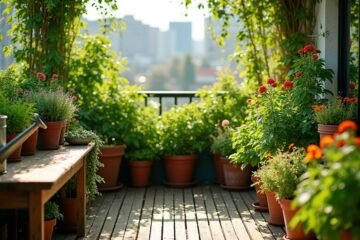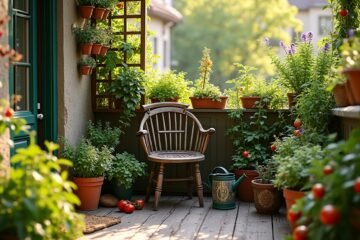Ready to spice up your balcony? Choosing herbs like basil and chives is a delightful start! Use lightweight pots with well-draining soil, so roots can thrive. Water deeply but let the soil dry a bit between visits—it’s like giving your herbs a little time to breathe! Make sure they soak up at least six hours of sun daily. Don’t forget to snip and harvest for extra flavor! Curious about pest control tips to keep your herbs healthy? Keep going!
Choosing the Right Herbs for Your Balcony
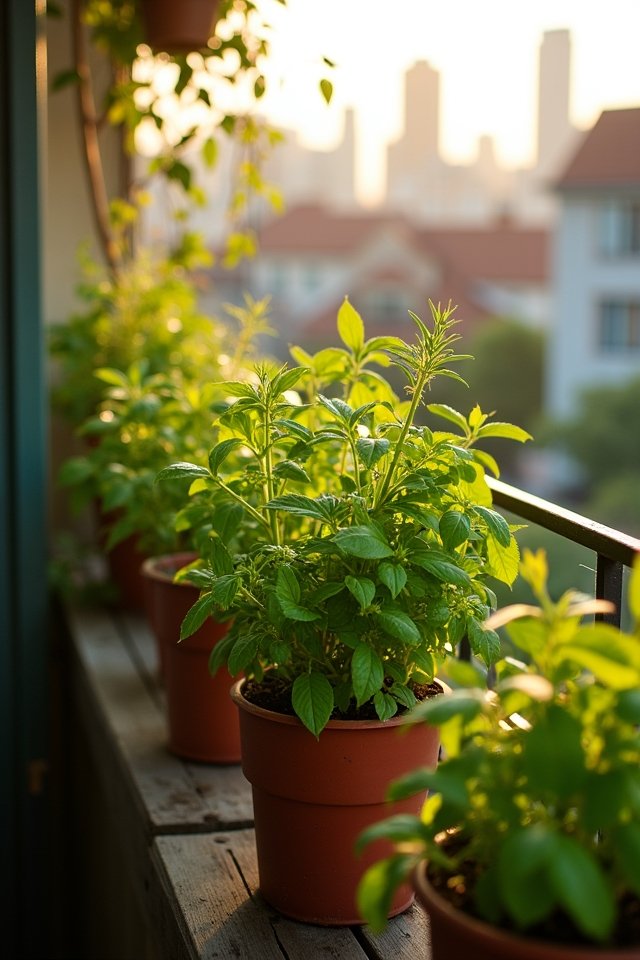
Are you ready to transform your balcony into a fragrant oasis? Choosing the right herbs makes all the difference! Think about herb compatibility—some plants thrive together, while others can clash like unsuitable roommates. For a lively summer, try basil and tomatoes; they’re perfect pals! When autumn rolls around, consider seasonal herbs like sage or rosemary that bring warmth to chilly nights. Plant them in charming pots, where their scents waft through the air, tantalizing your senses. Imagine snipping fresh chives for your baked potatoes or fragrant mint for a rejuvenating drink! It’s like having an aromatic buffet right outside your door! So, let your creativity blossom and select herbs that not only taste great but also play nicely together!
Optimal Soil and Pot Selection
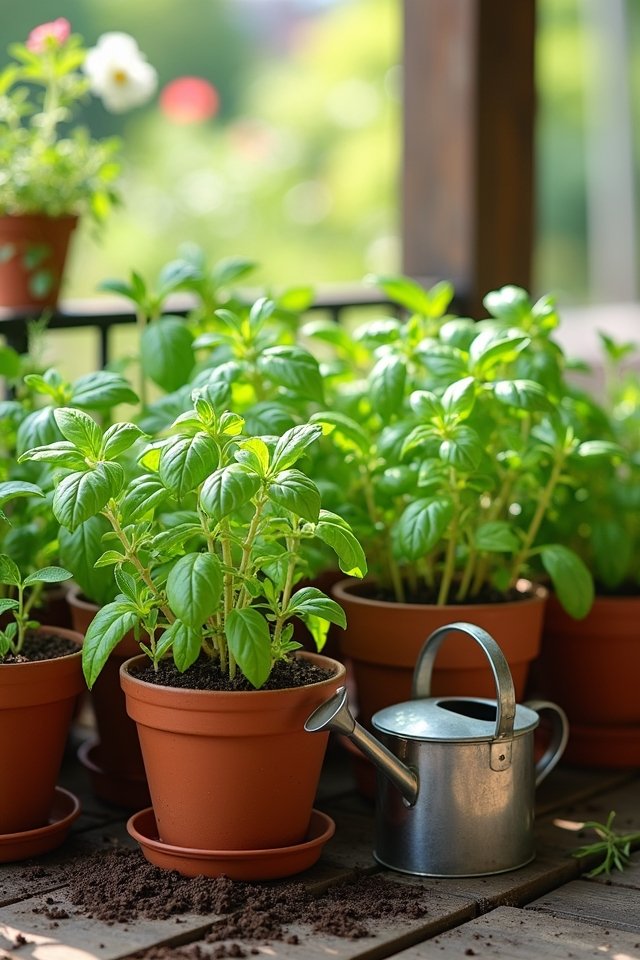
When it comes to planting your balcony herb garden, the right soil and pots can make all the difference! You want to create a serene haven for your herbs, and that starts with smart selections. Here are some tips to keep in mind:
- Choose well-draining soil types like potting mix or a blend of peat and perlite.
- Opt for lightweight pot materials such as plastic or fiberglass to ease handling and drainage.
- Avoid terracotta unless you’re up for regular watering; they’re thirsty pots!
- Consider self-watering pots for a little extra help; they’re like a spa day for your herbs.
With the right ingredients, you’ll have happy, thriving herbs in no time! Isn’t that exciting?
Watering Techniques and Schedules
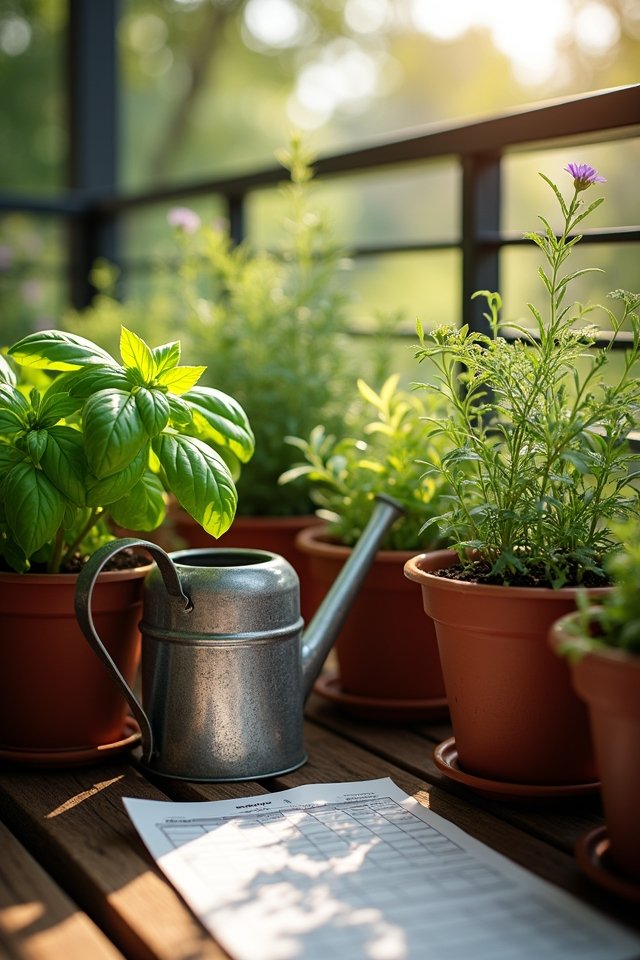
Once you’ve picked the perfect pots and soil, it’s time to turn your attention to watering your herbs—think of it as giving them their daily drink of sunshine! First off, make sure your pots have solid drainage solutions; nobody likes soggy feet! Water deeply, allowing moisture to soak into the roots, but let them dry out a tad between drinks. Remember, herbs thrive on a lovely balance of moisture retention. Try to water in the morning to prevent evaporation—gotta keep those nutrients cozy! If you’re unsure, stick your finger in the soil; if it feels like a slightly damp sponge, you’re golden! And hey, don’t forget to cherish that aromatic fragrance as you water!
Sunlight Requirements for Healthy Growth
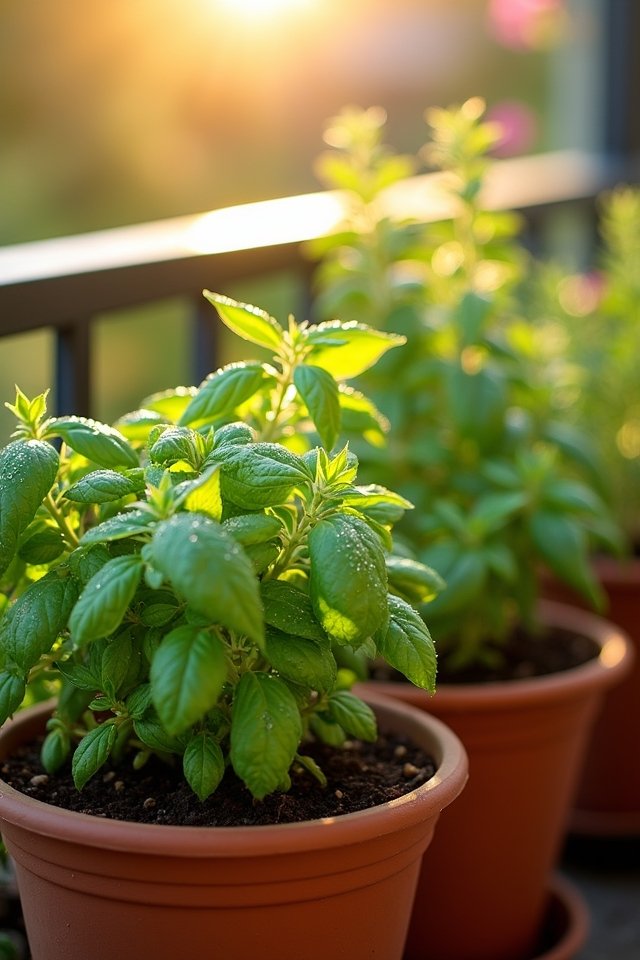
While you’re enthusiastically growing your balcony herb garden, let’s talk about the sunshine—your herbs’ best friend and not just a source of warmth! It’s essential to grasp that different herbs thrive under varying light intensity. Here’s what you need to know:
- Basil loves full sun (at least 6 hours a day).
- Mint has some shade tolerance; it can handle about 4-6 hours.
- Parsley prefers part sun, soaking up rays for 4-5 hours.
- Cilantro likes cooler spots with partial shade and about 4 hours of light.
Balancing this sunlight helps your herbs flourish! Imagine fresh basil sprigs dancing under the sun! Just remember, too much heat can scorch them, so a little shade can be heavenly!
Pruning and Harvesting Your Herbs
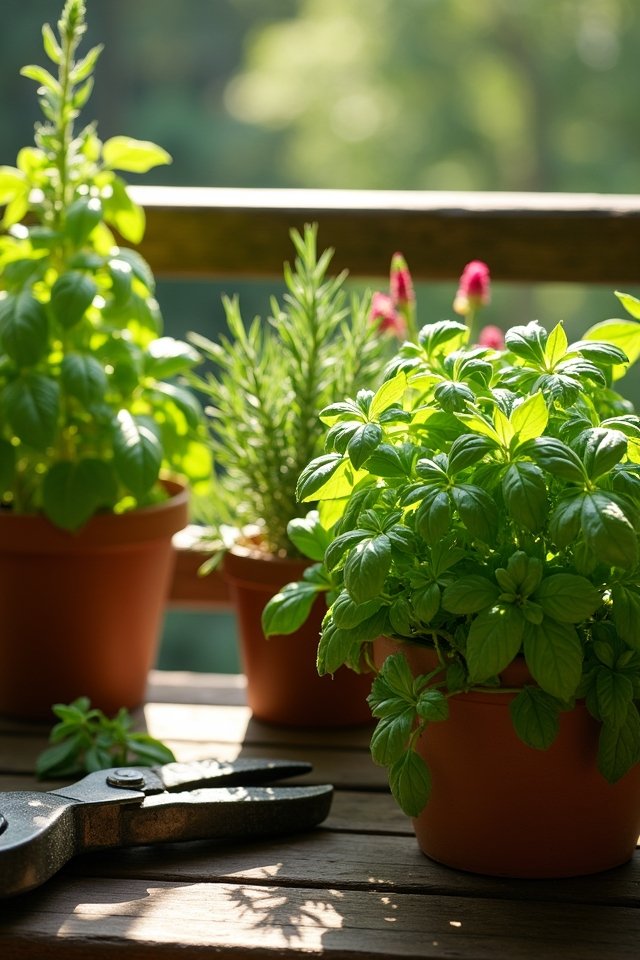
Snip, snip! It’s time to transform your balcony herb garden into a flavorful paradise! Regular pruning not only promotes healthy growth but also boosts your herb’s flavor. Aim for a pruning frequency of every two weeks—just the right amount to keep your plants vibrant and lush. Use innovative harvesting techniques like pinching off leaves, which encourages bushy growth. Imagine plucking fresh basil or mint right before adding it to your favorite dish! The aroma will tantalize your senses! Remember, always remove the top third of the herb stems for maximum yield without stressing the plants. So, grab those scissors and bring on the herb-raising adventure! Your culinary creations will thank you! Happy snipping!
Pest Control and Disease Prevention
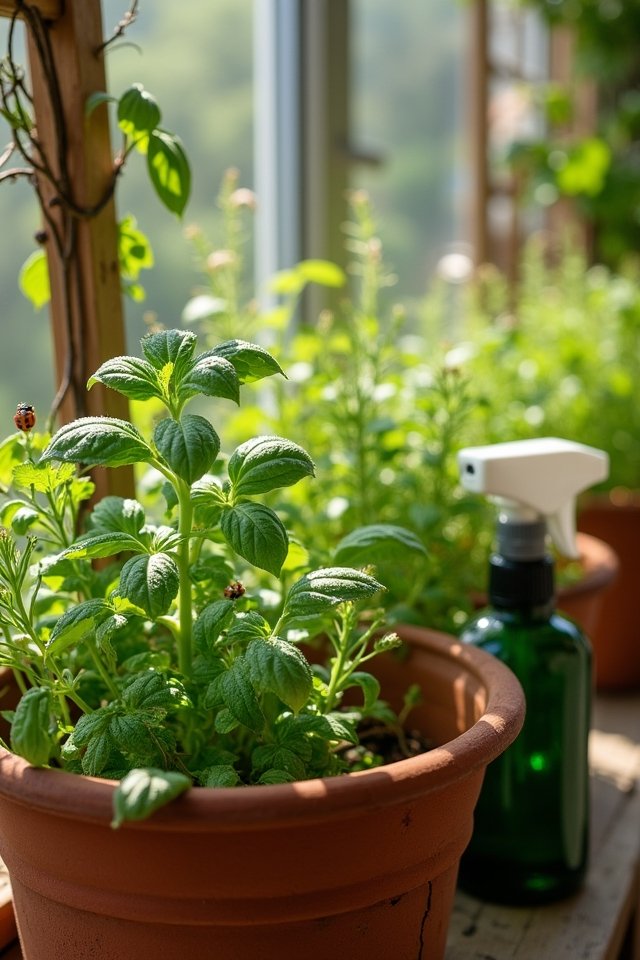
How do you keep your balcony herb garden thriving and pest-free? It’s simpler than you’d think! Here are some innovative tips to keep those pesky pests at bay while keeping your herbs healthy and delicious:
- Invite natural predators like ladybugs and lacewings. They’re the superhero squad for your garden!
- Use organic treatments such as neem oil or insecticidal soap. They’re your garden’s gentle warriors against unwanted visitors.
- Rotate your herbs every season to disrupt pest life cycles. It’s like changing the locks on your door!
- Keep your garden clean: remove dead leaves and debris. Think of it as tidying up your apartment—less clutter, more joy!
Frequently Asked Questions
Can I Grow Herbs Indoors if Balcony Space Is Limited?
Absolutely, you can grow herbs indoors like a pro chef whipping up a delicious sauce! When balcony space is limited, indoor herb gardening becomes your secret weapon. Consider using vertical planters or hanging pots—these are fantastic limited space solutions. Basil, mint, and parsley thrive under grow lights, making your kitchen smell enticing! Plus, it’s like having a tiny garden party right in your home. Who wouldn’t love freshly picked flavors at their fingertips?
How Do I Know if My Herbs Are Getting Enough Sunlight?
To know if your herbs are getting enough sunlight, pay attention to their leaves! If they’re bright green and sturdy, you’re likely on the right track. But if they start to stretch toward the light—like they’re part of a dramatic plant audition—it’s a sign they need more sun! Most herbs crave about six hours of direct light daily. So, reposition them if they resemble sad little peas in a pod, and watch them flourish!
What Is the Best Temperature for Growing Herbs on a Balcony?
When it comes to growing herbs, you can’t let the heat get to you! Most herbs thrive between 60°F and 75°F. Think of it as their sweet spot! For seasonal herb growth, basil loves the summer warmth while parsley enjoys a cooler kiss from spring. So, keep an eye on their herb temperature preferences. A little temperature magic can make all the difference—your delicious creations will thank you for it! Happy gardening!
Can I Use Kitchen Scraps for Herb Fertilization?
You can use kitchen scraps for herb fertilization like a pro gardener! Kitchen composting is your secret weapon, turning potato peels and coffee grounds into rich herb nutrients. Just imagine feeding your plants with leftovers! Toss in banana peels for potassium or eggshells for calcium—they’ll thrive and perk up, just like your favorite morning coffee! So, next time you slice veggies, think about enhancing your herbs instead. It’s a win-win!
How Often Should I Rotate My Pots for Even Sunlight Exposure?
You should rotate your pots every week for even sunlight exposure. Think of it like giving each herb its fair share of sunshine, just like a sunny beach day! As the sunlight angles change, your plants need that premium real estate. Move those pots around, creating a little dance of greenery! It’s a simple way to keep your herbs thriving, lush, and oh-so-happy. Who knew sunbathing could be this fun?

